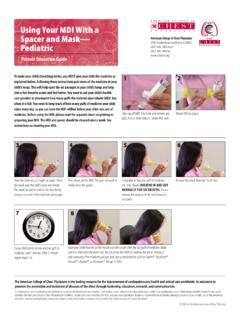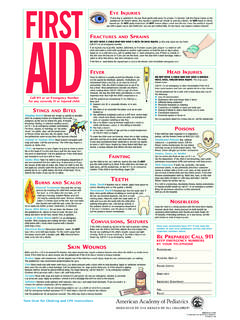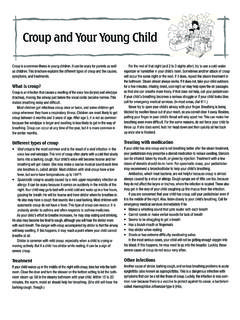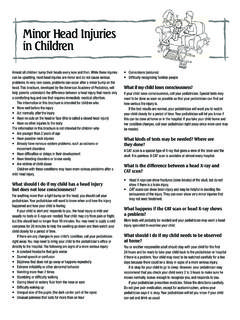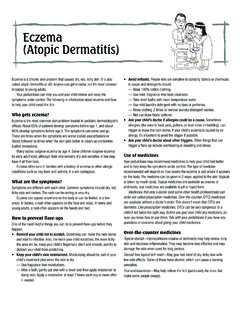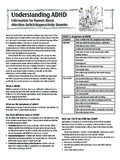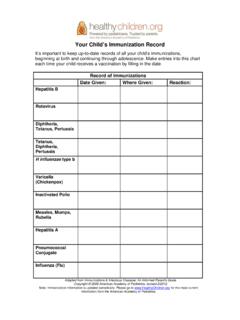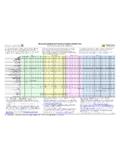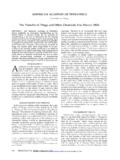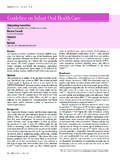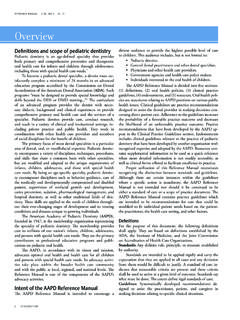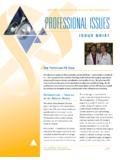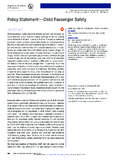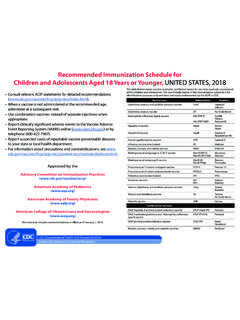Transcription of Home Safety Checklist - Pediatric Spec
1 Is your house a safe place for your child to live and play? The following Safety Checklist can help you prevent serious injuries or even death. Though it addresses common Safety concerns, it s important to remember that every house is different and no Checklist is complete. Because there may be other Safety concerns in your house, a more thorough Safety check is recommended at least every 6 child s bedroomChanging table Never leave your child unattended. Keep supplies within arm s reach and always use the Safety belt to help prevent falls.
2 Try to keep a hand on your child at all times, even when using the Safety belt. Make sure drapery and blind cords are out of reach. Loose cords can strangle children. Keep the cords tied up high with no loops. Check the cords in other rooms as well. If you use baby powder, pour it out carefully and keep the powder away from baby s face. Published reports indicate that talc or cornstarch in baby powder can injure a baby s Lower the risk of sudden infant death syndrome (SIDS). All healthy babies younger than 1 year should sleep on their backs at nap time and at night.
3 The safest place to sleep is in a crib with a firm mattress with a fitted sheet. Keep pillows, quilts, comforters, sheepskins, and stuffed toys out of your baby s crib. They can cover your baby s face even if she is lying on her back. Also, bulky items left in the crib could be used as a step for climbing out when your baby is able to stand. Don t hang anything with strings or ribbon over cribs. Make sure the crib has no raised corner posts or cutouts. Loose clothing can get snagged on these and strangle your baby.
4 Also, the slats on the crib should be no more than 23 8 inches apart. Widely spaced slats can trap small heads. Use a mattress that fits snugly in the crib so your baby cannot slip in between the sides of the crib. Tighten all the screws, bolts, and other hardware securely to prevent the crib from collapsing. Other bedroom items Night-light. Keep night-lights away from drapes or bedding where they could start a fire. Buy only cool night-lights that do not get hot. Smoke alarms. Install smoke alarms outside every bedroom (or any area where someone sleeps), in furnace areas, and on every level of your home , including the basement.
5 Buy alarms with long-life lithium batteries. Standard batteries should be changed every year. Test alarms every month to make sure they are working properly. Window guards. Make sure window guards are secured to prevent a child from falling out the window. Outlets. Use plug protectors in all outlets in your home . Children can be burned or shocked from sticking their fingers or other objects into the holes. Toy chest. The best toy chest is a box or basket without a lid. However, if it has a lid, make sure it has safe hinges that hold the lid open and do not pinch.
6 The chest should also have air holes just in case your child gets trapped inside. Humidifier. Use a cool-mist humidifier to avoid burns. Clean it often to avoid bacteria and mold growth. The kitchen Store sharp knives or other sharp utensils and dishwasher detergent and other cleaning supplies in a cabinet with child locks. Keep chairs and stools away from counters and the stove where a child could climb up and get hurt. Use the back burners and point pot handles toward the back of the stove to keep them out of your child s reach.
7 Keep your child away from the stove when someone is cooking. Keep electrical appliances out of your child s reach and unplugged when not in use. Appliance cords should be tucked away so they cannot be reached by a child. Use a high chair that is sturdy and has a seat belt with a crotch strap. Keep a working fire extinguisher in the kitchen and know how and when to use it. The bathroom Always stay within arm s reach of your infant or young child when he is in the bathtub. Many bathtub drownings happen (even in a few inches of water) when a parent leaves an infant or young child alone or with another young child.
8 Keep the bathroom door closed when not in use. Keep the toilet seat cover down and consider using a toilet lid latch. Use a doorknob cover to keep your child out of the bathroom when you are not there. Use a nonskid bath mat in the bathtub and on the floor. Keep all medicines, toiletries, cosmetics, and cleaning supplies out of your child s reach. Store these items in cabinets with child locks. Make sure all medicines have child-resistant caps on them. Unplug and store hair dryers, curling irons, and other electrical appliances out of your child s reach.
9 Make sure the outlets in the bathroom have ground fault interrupters (GFIs). The hottest temperature at the faucet should be no more than 120 F to avoid burns. In many cases you can adjust your hot water heater. home Safety ChecklistThe american academy of Pediatrics is an organization of 60,000 primary care pediatricians, Pediatric medical su bspecialists, and Pediatric surgical specialists dedicated to the health, Safety , and well-being of infants, children, adolescents, and young adults. american academy of Pediatrics Web site 2008, Updated 12/08 american academy of PediatricsAll rights family room Pad edges and corners of tables.
10 Keep houseplants out of your child s reach because some may be poisonous. Make sure TVs and other heavy items (such as lamps) are secure so they don t tip over. Check electrical cords. Replace any cords that are worn, frayed, or damaged. Never overload outlets. Cords should run behind furniture and not hang down for children to pull on them. Remove unused cords. Place a barrier around the fireplace or other heat sources. Store matches and lighters out of your child s reach or in a cabinet with child locks.
